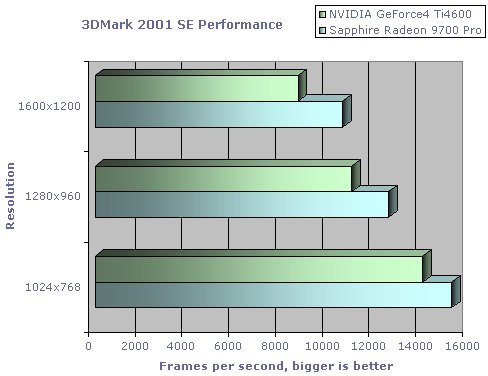Quake3 and 3DMark 2001 SE
So, before we start, what should we expect to see? Traditionally at the lower resolutions with Ti4600 the system is the bottleneck and the card sits twiddling its silicon thumbs. Even with 2.8C we might still see that. When the going gets tough at the higher resolutions, the real fight should start and we'll see what the difference in performance is. Here goes then.

To give you a better idea about what's going on here, here's the percentage difference at each resolution.
• 1024x768 - 9.00%
• 1280x1024 - 14.38%
• 1600x1200 - 21.80%
A 9% difference at the lowest resolution shows us that we are close to being system card limited but not quite. Still ever so slightly card bound at stock, given the same CPU. The pixel fillrate advantage on the R9700 along with the bandwidth optimisation techniques are responsible for the 14% and 22% increases over Ti4600 as the work gets harder for the cards. This is going to be the case for pretty much all the tests you'll see. How about Quake3?

Here's the percentage breakdown again.
• 1024x768 - -0.04%
• 1280x1024 - 9.84%
• 1600x1200 - 25.70%
Identical performance at 1024x768 means the cards are sat twiddling their thumbs waiting for the test system to feed them data. Things open up at the higher resolutions culminating in another 20%+ win for the Radeon. Card memory bandwidth does it here, GPU clock and hence texel/pixel fillrate has less effect.
So we can see straight away that all that extra memory power on the Radeon 9700 Pro is helping. Relative parity in GPU power in terms of texel fillrate at least is helping the Ti4600 keep up until we get to 1600x1200.
A DX8 shader heavy game and a pseudo-DX6 OpenGL stalwart so far, similar patterns emerging for both. Lets peek at UT2003 and Serious Sam 2 with a little Code Creatures for good measure.









